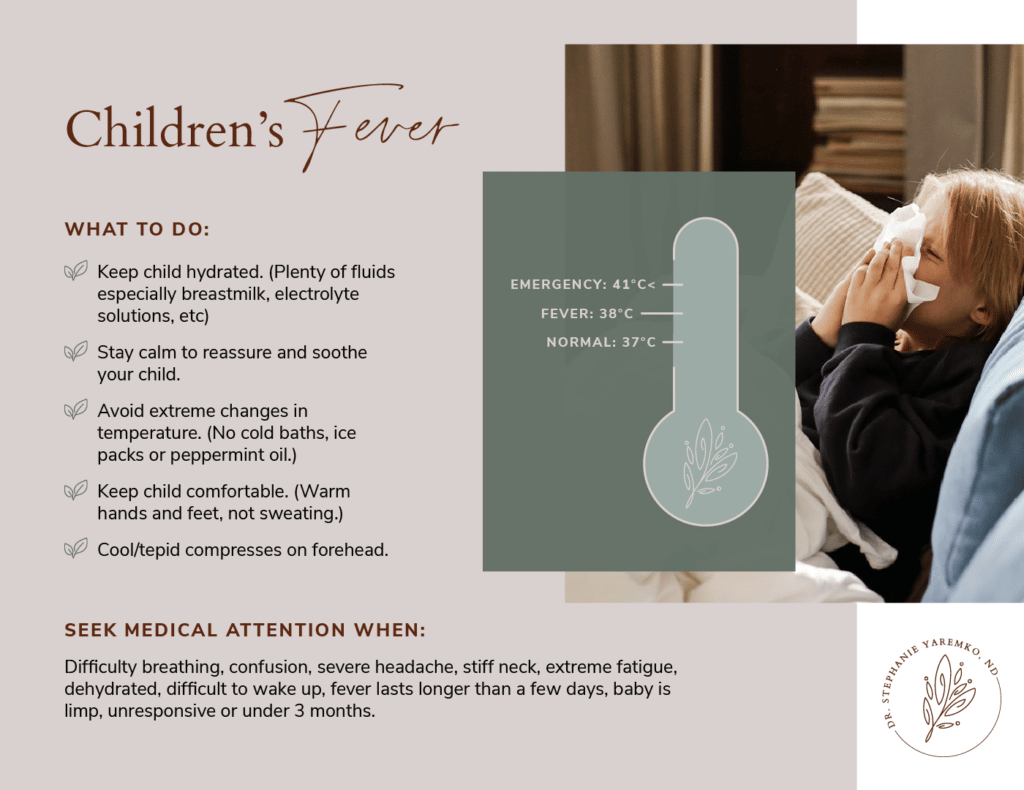blog post
Understanding Fevers in Children 11 and Younger

Fevers are a common symptom in children and can be caused by a variety of illnesses, both minor and serious. While they can be concerning for parents, fevers are actually the body’s healthy response to fighting off infections.

So, what exactly is a fever?
A fever is simply an elevated body temperature. The average normal body temperature for a child is around 37°C (98.6°F), with normal increases to just below 38°C (100.4°F) caused by things like physical activity or warm weather. At 38°C (100.4°F) we start considering it fever.
How to measure a child’s temperature
Temperature varies depending on how you take it. The most common ways to measure it are:
- Under the tongue.
- In the armpit.
- In the rectum.
- In the ear.
You can also use:
- Forehead temperature strips.
- Pacifier thermometers.
Some methods may not be as reliable or accurate as others. For information about taking accurate temperatures, see the topic Body Temperature.
Fevers aren’t all bad…
It’s important to remember that children often run higher fevers than adults, but this doesn’t necessarily mean their illness is more serious. Fevers can be caused by both viral infections like colds and the flu, and bacterial infections like urinary tract infections. Most fevers in healthy children are not dangerous and go away within 3 to 4 days.
Fevers in babies
Babies younger than 3 months should be seen by a doctor if they have a fever because they can get very sick, quickly. High fevers can be uncomfortable for children, but they rarely cause serious problems. In fact, there is no evidence that fevers from infections cause brain damage. However, outside heat (such as being in a hot car) can cause body temperatures to rise above 41.5°C (107°F) and potentially lead to brain damage.
Common causes for fever in children
It’s common for preschool-aged children to have 7 to 10 viral infections in a year, each of which may cause a fever.
Common causes of fever include:
- Viral infections , such as colds, flu, and chickenpox(although the latter is much less common now due to immunization.)
- Bacterial infections , such as a urinary tract infection.
- Immunizations.
Teething does not generally cause a fever, although it can mildly elevate temperature. If a baby is teething and has a fever, look for other symptoms that may need to be evaluated.
In rare cases, a fever that increases quickly can lead to a febrile seizure in some children. After a fever has reached a high temperature, the risk of a seizure is reduced. If your child has a high fever and a seizure, it’s important to see a doctor.
Fevers are a normal and healthy response to illness in children. While they can be concerning for parents, most fevers in healthy children are not dangerous and go away within a few days. If you have concerns about your child’s fever, consult a doctor.
What to do if you child has a fever
If your child has a fever, here are the steps you can take:
- Give fluids to avoid dehydration
- Keep your child comfortable and resting. This can include light weight clothing and covers, tepid wash cloths on the forehead and being in a calm, dim environment. Do not use ice, rubbing alcohol or aspirin for a fever.
- Look for other symptoms of illness
- Keep an eye on your child and observe for any changes in their condition
- See a doctor if your child is younger than 3 months, has a fever that lasts for more than 3 days, has a high fever, shows signs of dehydration or refuses fluids, has other symptoms of a serious illness, or as a parent you feel that something is “not right”.

behind the blog
Dr. Stephanie Yaremko
Teaches wholesome practices for individuals and families who want to take health and happiness to the next level.
